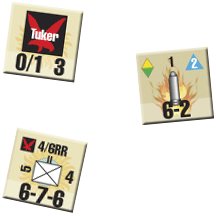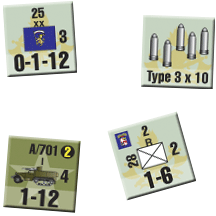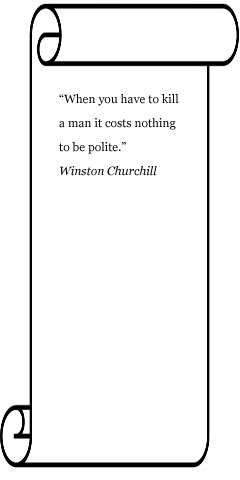| Decisive
Ratings
By Mike Bennighof, Ph.D.
January 2014
Any game's "engine" rests on a
number of interlocking design decisions, and
for traditional wargames these normally include
map scale, unit scale, time scale, and the
ratings of the units. The games we used to
call "Decisive Battles" and pretty
much gave up on branding as a series have
more ratings than most.
 The
series, such as it is, began in 1994 with two examples currently in print, Alamein and Island
of Death. We bill the series as "battalion scale,"
and that's technically accurate: most of the
units are battalions. However, they are almost
always grouped into divisions (about six to
nine battalions, plus support units) and most
of the important decisions made by players
concern what the divisions will do. Placing
the battalions and assigning them individual
tasks within the division's overall mission
is detail work. The
series, such as it is, began in 1994 with two examples currently in print, Alamein and Island
of Death. We bill the series as "battalion scale,"
and that's technically accurate: most of the
units are battalions. However, they are almost
always grouped into divisions (about six to
nine battalions, plus support units) and most
of the important decisions made by players
concern what the divisions will do. Placing
the battalions and assigning them individual
tasks within the division's overall mission
is detail work.
To emphasize that concept, we rarely let
battalions vary in quality within a division
— that would encourage players to pick
and choose between them, and also give them
a level of information not available to their
historical counterparts. Army commanders,
then as now, couch their orders in terms of
"send three battalions to Hill 242,"
and usually do not pick out the division's
three best by name.
There are exceptions. The 2nd New Zealand
Division's excellent 28th
Maori Battalion is portrayed as a much
more capable unit than the division's other
infantry battalions as seen in Alamein.
The first and second battalions of Romanian
Frontier Guard regiments, seen in the long out-of-print Red Steel, are better than the
third: The first two were composed of long-service
regulars, the third mostly of reservists.
The units themselves follow an ancient principle
of wargame design, handed down to me from
John Prados many years ago, who probably got
it from Prometheus himself: the number 4.
Four is a magic number for game design. Rarely
will a unit be four times as powerful as another
in the same game (if it were, it would more
than likely be represented as two or more
separate units). Therefore, you have very
few units at a strength of 1 and no need to
represent any at less than that strength.
At the opposite end of the same, not many
units will be two and a half times as strong
as a standard, average unit, and so you avoid
unit strengths in double digits (something
that maddens graphic designers, and is often
the sign of inelegant game design as well).
 I
don't like violating this principle, but the
series does manage to do so for its more powerful
units. This is due to the concept of "step
reduction." Battalions at full strength
have three or four "steps," or levels
of strength, in this game system. They rarely
evaporate completely as the result of a single
action, instead wearing away gradually over
some time. This is one of the series' real
strengths as a means to portray historical
battles, as players see their divisions gradually
lose strength the longer they remain in combat.
But is also means that some of the more powerful
battalions (usually tank units) do have attack
or defense strengths of 10 or more at full
power. Fortunately, battalions of that size
are usually deployed at company strength (the
battalion piece is "broken down"
and replaced on the map with three or four
smaller units) and will usually suffer combat
losses fairly quickly, as it will no doubt
be at the center of the action. I
don't like violating this principle, but the
series does manage to do so for its more powerful
units. This is due to the concept of "step
reduction." Battalions at full strength
have three or four "steps," or levels
of strength, in this game system. They rarely
evaporate completely as the result of a single
action, instead wearing away gradually over
some time. This is one of the series' real
strengths as a means to portray historical
battles, as players see their divisions gradually
lose strength the longer they remain in combat.
But is also means that some of the more powerful
battalions (usually tank units) do have attack
or defense strengths of 10 or more at full
power. Fortunately, battalions of that size
are usually deployed at company strength (the
battalion piece is "broken down"
and replaced on the map with three or four
smaller units) and will usually suffer combat
losses fairly quickly, as it will no doubt
be at the center of the action.
Because of the step loss mechanic, I tend
to look at the second step as the "average"
strength of more powerful battalions. Thus
German infantry battalions in Red Steel
have a full-strength rating of 7-6 (combat-movement),
but are at 5-6 once they've lost a step. Romanian
infantry battalions are rated at 5-6-6 (attack-defense-movement)
or 5-7-6, but only 3-4-6 at their second step,
and Soviet ones at 4-6 (and usually only have
two steps). Combat is odds-based, and this
means that these small differences are much
more likely to show up when multiple battalions
are involved in battle. One Romanian battalion
attacks one Soviet battalion at odds of 1:1,
but four Romanian battalions attacking that
same Soviet battalion rate odds of 5:1 instead
of just 4:1.
Just how those numbers are derived usually depends on the
battalion's parent formation. Commonwealth
infantry battalions in Alamein are
usually rated at 6-7-6. Some are a little
better (Australians and New Zealanders are
7-6), some are a little worse (the British
44th Division and Indian 10th Division are
6-6). Italian troops of the 102nd "Trento"
Division, a good unit, are also 6-6, but those
of the 27th "Brescia" Division are
only 4-5-6.
Differences between the units are based on
size, weapons and some slight variations for
experience and ability. In a larger sense,
this is almost always a direct reflection
of their country's wealth and the strength
of its military/industrial complex. Units
from modern industrial economies usually go
to war with more automatic weapons, greater
stocks of ammunition, and better training.
Thus German, British and American troops are
rated very highly compared to those of Italy,
Romania or the Soviet Union.
 But
numbers and weapons do not tell the whole
story, or even most of it. Units are also
rated for morale, which reflects small-unit
leadership, unit coherence and general ability
in combat. That tough Maori battalion is rated
8-6, but has a morale of 6. When attacking
a 4-6 Italian infantry battalion, the odds
would begin at 2:1. But since the Italians
only have a morale of 3, the differential
would raise the combat odds to 5:1 (up three
levels for the difference in morale). That's
an extreme example, but illustrates the impact
of morale ratings. But
numbers and weapons do not tell the whole
story, or even most of it. Units are also
rated for morale, which reflects small-unit
leadership, unit coherence and general ability
in combat. That tough Maori battalion is rated
8-6, but has a morale of 6. When attacking
a 4-6 Italian infantry battalion, the odds
would begin at 2:1. But since the Italians
only have a morale of 3, the differential
would raise the combat odds to 5:1 (up three
levels for the difference in morale). That's
an extreme example, but illustrates the impact
of morale ratings.
The usual morale rating is 4, continuing
the magic number principle, which also allows
for game mechanics built around a single die
roll (a player must roll a die and get a result
less than or equal to the unit's morale rating
for it to perform certain functions). Some
units receive a 5: Australian and New Zealand
regulars, the tough Italian Ariete Division,
many German divisions, Soviet Guards. A 6
is very rare, held by the German Afrika Korps
divisions and Italian paratroopers in Alamein
(I would have given it to the New Zealander
myself, and rated the Maoris a 7, but that's
the designer's decision). The only units with
a 7 rating are some German parachute battalions.
On the negative end of the scale, Italian
line infantry divisions usually only rate
a 3.
All of those ratings interact with armor
and artillery to model World War Two-era combat
very well. A smaller force with superior morale
and armor can inflict massive damage on a
large opponent.
Click
here to order Alamein today! |


